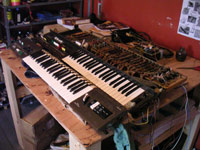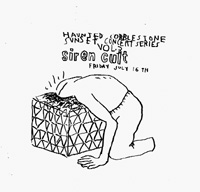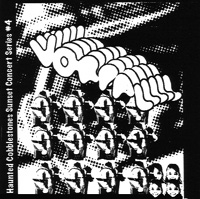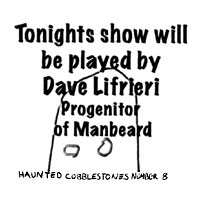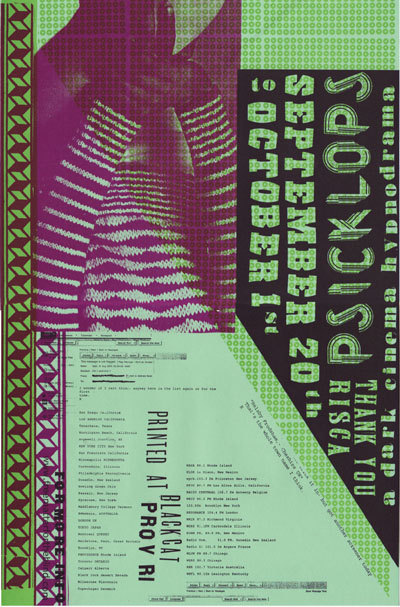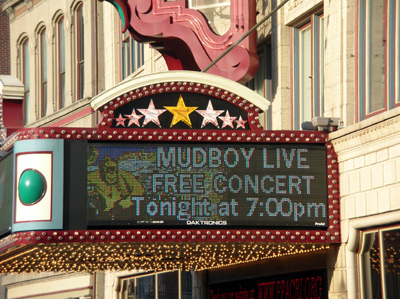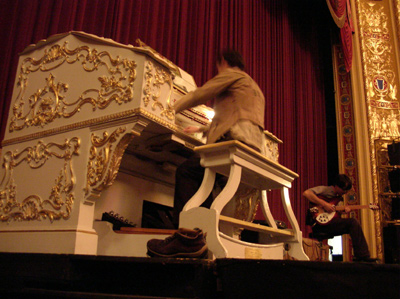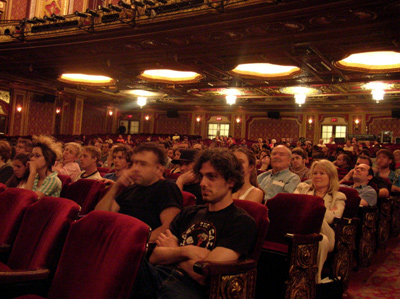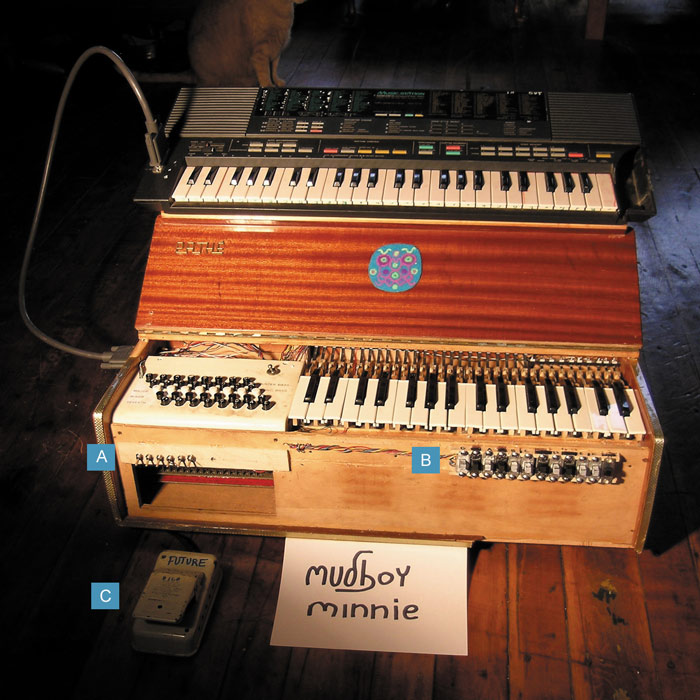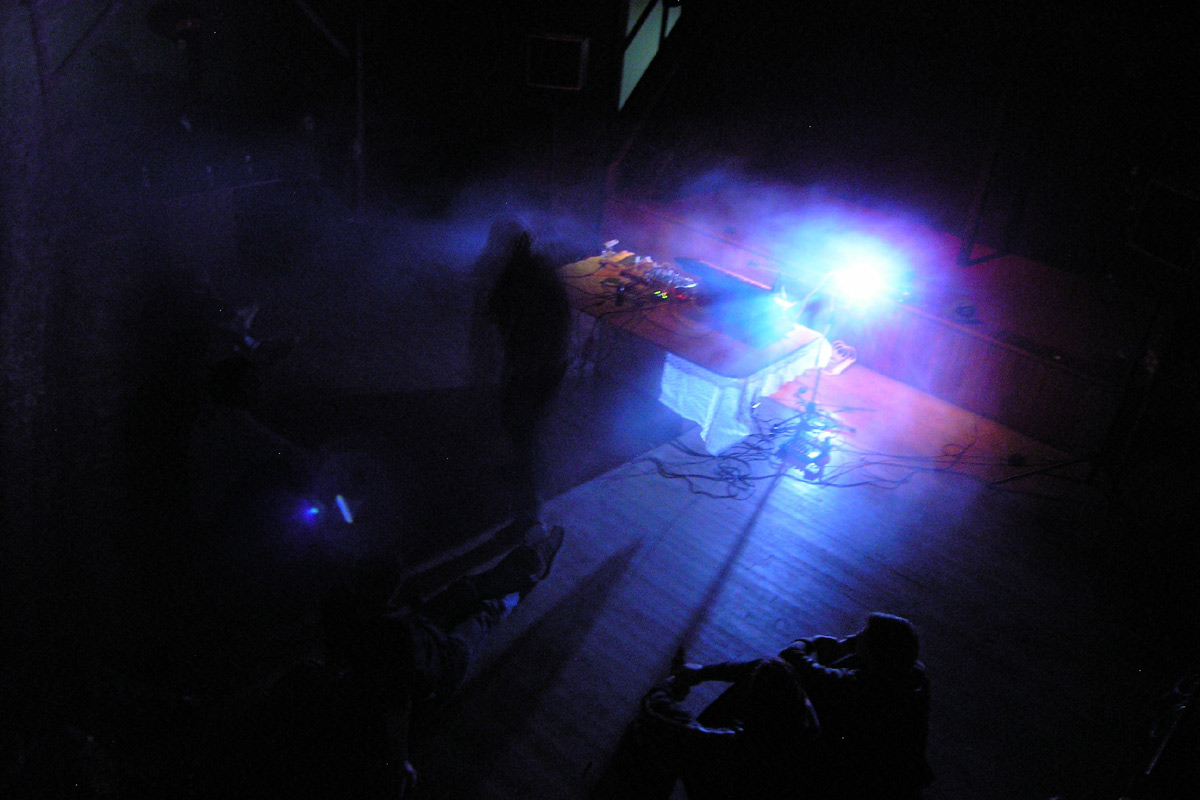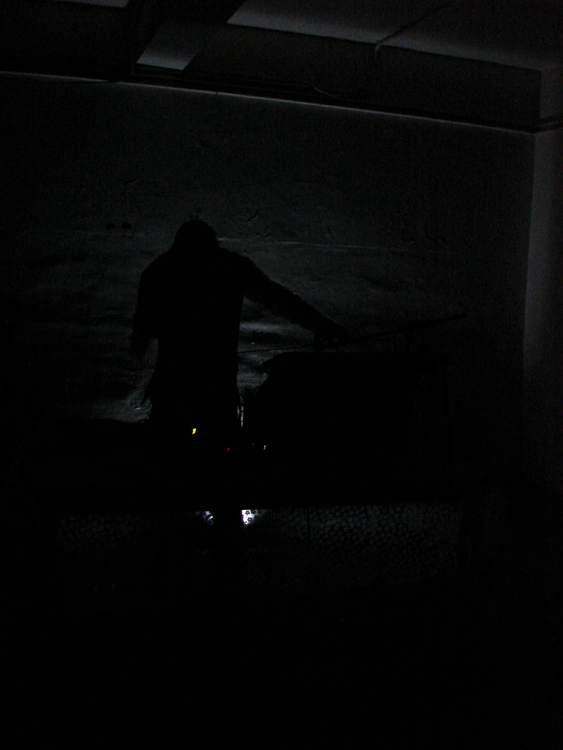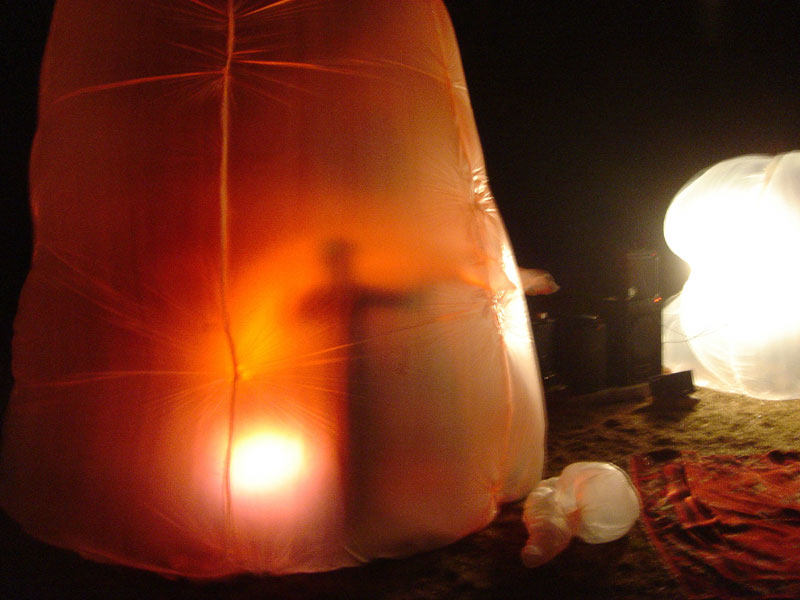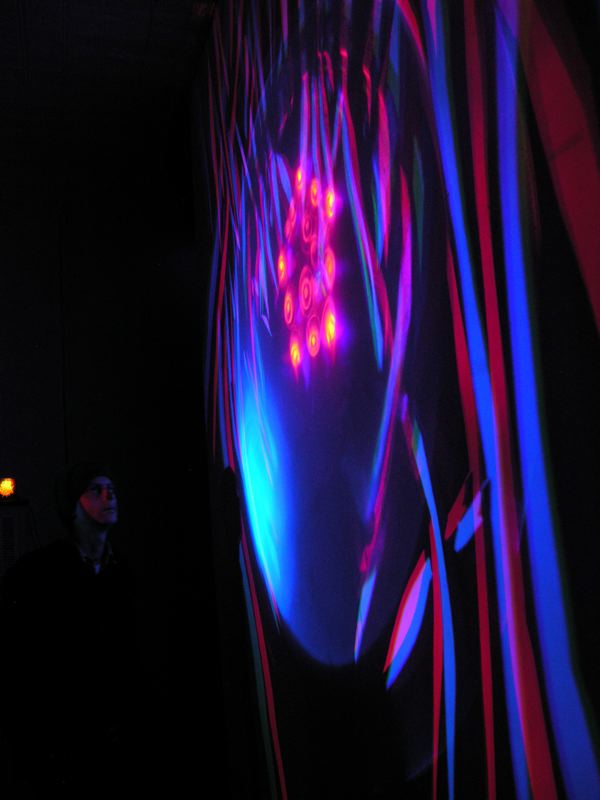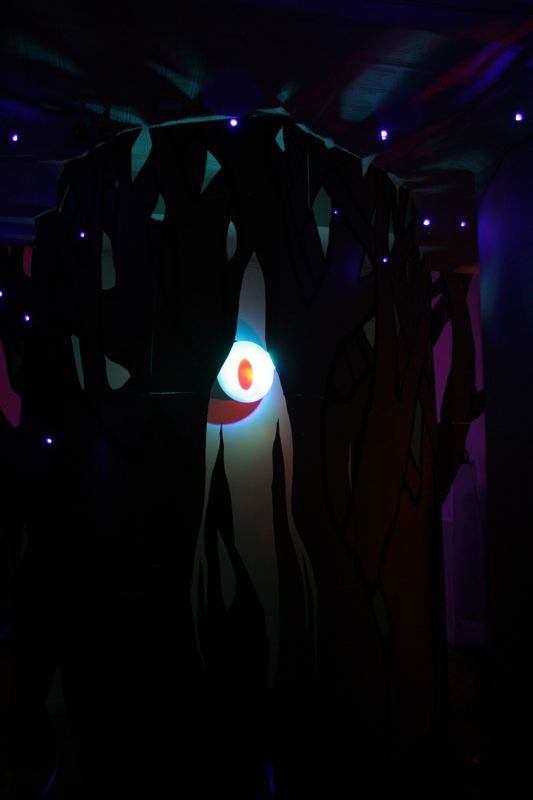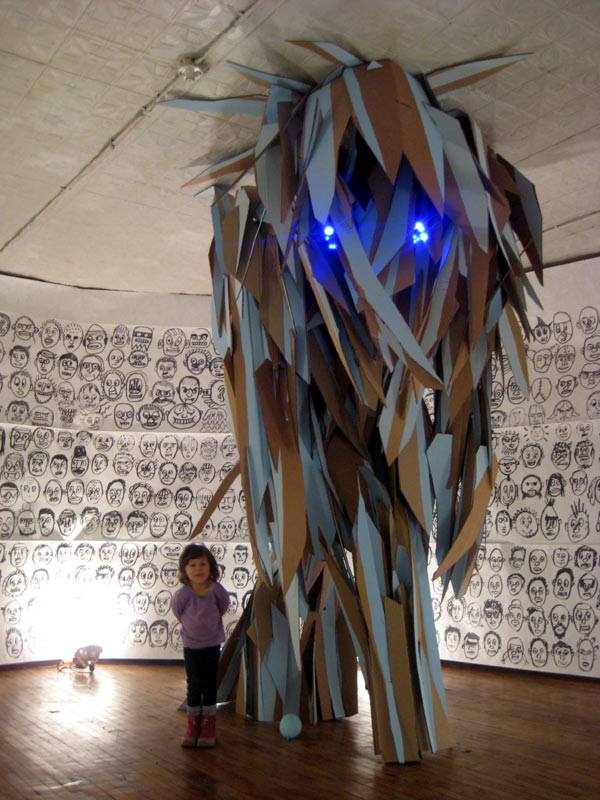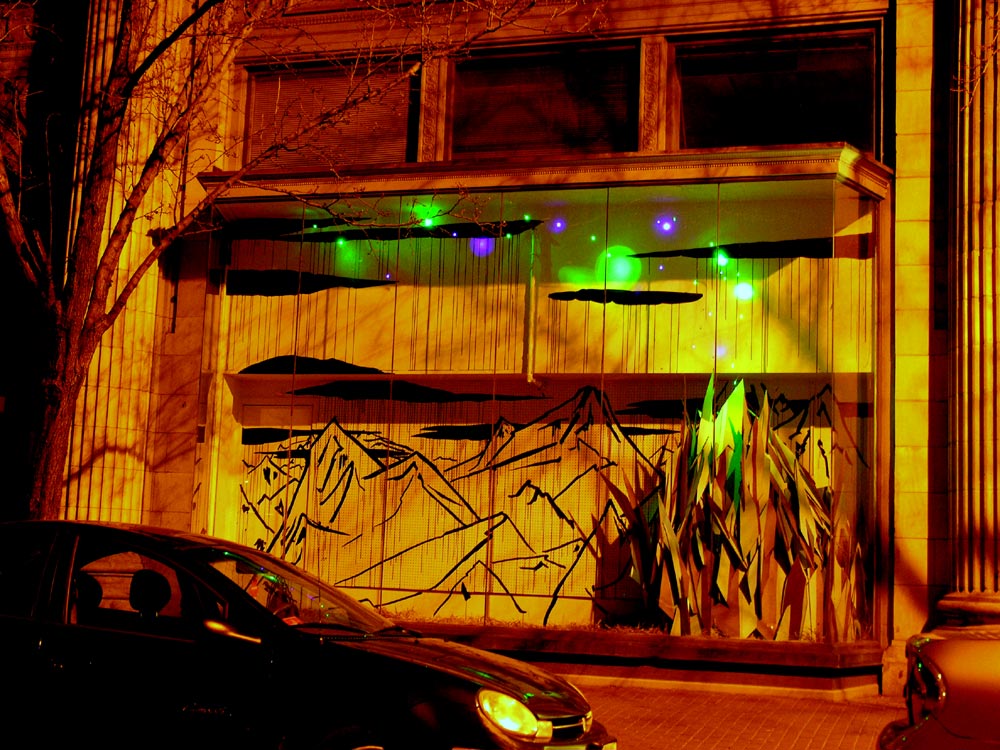INTRODUCTION:
Following
the recommendations of Bradford Garton and Fred Lerdahl, I will not be
submitting scores, and have instead included a essay that describes my ideas
and work
with links to sample recordings and documentation. As an artist who rarely
uses notation as the basis for compositional ideas, I know I am
an untraditional applicant; consequently, I have chosen to give the program
a
sense of myself and what I can offer through a sampling of pieces recorded
over the last ten years, as well as through a conceptual discussion of
my work both past and present. My CV should you be interested is here.
As a self-taught composer with a successful career in music as well as visual
and performance art, I have toured extensively and had several solo shows
throughout the United States and Europe, and am currently represented by
the Mountain
Fold Gallery in New York City. I have released seventeen full length albums
under the name mudboy, along with dozens of smaller releases done as collaborations
with other artists, or as producer. My sense of composition remains extremely
broad, and the work that I have created ranges from autogenerative computer-assisted
scores to mighty Wurlitzer pieces; audio collage and field recording to
performative touring concerts ; immersive installations to kinetic
light paintings. The
media changes, but the fundamental idea—that composition is a tool
for the organization of non-literal, often unconscious experience—remains
the same. I remain committed to themes of perception, fractal organization
and living systems in their relation to cognition and experience. These
are the ideas I wish to continue researching in regards to composition
at Columbia, where I hope to study and produce challenging
music.
After many years of working almost exclusively within the world of experimental
and so-called underground music, I now recognize that, in order to become
a more sophisticated and fully-evolved composer, I must refine my abilities
in
classical forms and traditions of orchestration. Specifically, I want
to transform, or perhaps repurpose, the conceptual frameworks inside
of which
I have created
largely electronic pieces and apply them to conventional principles of
notation, while working in collaboration with contemporary ensembles
of traditional instruments.
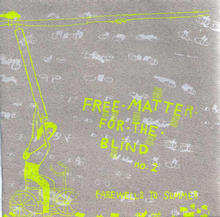
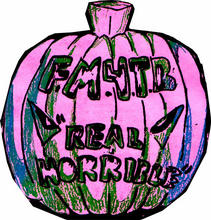
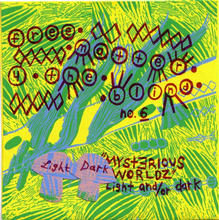
I. WORK, 1996-2008.
For the duration of the 1990s, I rarely touched a musical instrument.
Nonetheless, I was always drawn to sound, and much of my late teens
and early twenties
were occupied with field and found recordings, as well as the manipulation
of sounds using the format of the cassette tape. The result of this wide-ranging,
if irregular, work was the origin of an audio "zine" compilation
series entitled Free Matter for the Blind.
Sample
of combined excerpts from issue 2 "Farewells to Summer"
This series stretched through ten issues into early 2004 , and would eventually
become the basis for a record label by the same name.
With Free Matter for
the Blind, I have released albums including material such as straightforward
field recordings, experimental music, audio magazines, soundtracks to theater
pieces, and experimental computer work. In 2008, Free Matter for the Blind
was selected by the pioneering radio station WFMU to be an official curator
of its online free music archives. Most the label's out-of-print albums are
included in that archive.
When I enrolled in college, I knew nothing about alternative sound techniques
or practices; indeed, the strangest musical work with which I was familiar
was the spoken-word recordings of punk musician Jello Biafra, along with
some narrative or storytelling sections of the odd Bauhaus record. All
this changed when I began studying at Brown University, where I worked
with music
professor Todd Winkler in Brown's multimedia lab. Brown introduced me to
the likes of Stockhausen, Steve Reich, Pauline Oliveros, Laurie Anderson
and, most significantly, John Cage. I began to understand my work primarily
in musical terms, and to consider the act of composition itself as an aesthetic
practice. Though I continued to pursue alternative media forms , moving
away from two-track cassette and relying on computer programs to edit and
arrange,
I became increasingly interested in pushing the generic boundaries of music,
and, in particular, the potential for using artificial intelligence (in
the form of midi based MAX patches) to compose complex and sophisticated
pieces.
As may be clear, music, to my mind, remained a conceptual practice independent
from performance with "real" or regular instruments.
Several important compositions emerged from this period, one of which, "A
TOMY Holiday Album," was eventually released as limited edition CDr.
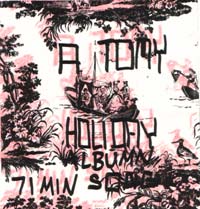
This piece features the live recording an automatically-composed (MAX), midi-triggered
orchestra. The tempo of the piece rises steadily over the seventy minutes of
the piece, whose final movement features the structural collapse of the individual
sounds, as the processor finds it cannot handle the increased demands of the
software, and ultimately crashes.
Sample
of the generative TOMY Holiday album
Sample of the last movement
After leaving the university, I became less enamored of using computer
software to generate music, though I continued to work on the audio zines
of Free
Matter. In 2000, I began living and working in the celebrated Fort Thunder
artist's collective in Providence , Rhode Island.

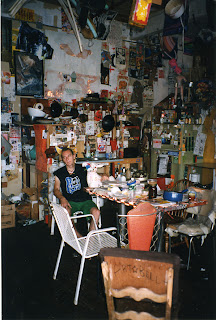
At the time, Fort Thunder
was perhaps the most
important underground music venue in the United States. It was
from this community that much of the early "noise" culture of
the early 2000s emerged, as experimental sound production and musical performance
was combined
with the visual art and printmaking practices of silkscreen and
poster
work. 
 The
multimedia artists Dear Raindrop, Forcefield, and Paper Rad
are all associated
with the cultural impact of Fort Thunder, as are critically-acclaimed
bands like Lightning Bolt, Black Dice, SEG, and Lucky Dragons,.
The
multimedia artists Dear Raindrop, Forcefield, and Paper Rad
are all associated
with the cultural impact of Fort Thunder, as are critically-acclaimed
bands like Lightning Bolt, Black Dice, SEG, and Lucky Dragons,.
Despite Fort Thunder's acceptance by an international audience, those
of us who lived there were most passionate about its roots as a
home for
artists and musicians inspired primarily by the political cultures
of anarchism and survivalism. Aesthetically, I would say we were interested
in the discarded flotsam
of
late capitalist civilization, and it was from there that we took
both our
inspiration and our materials: my world was filled with bright
trash, analog synths, and toy instruments. Computers, which were fragile,
temporary and
expensive, were looked down upon and so, simply, not around. I
was
still fascinated, however, with the creative potential of autonomatic
composition,
and so began to pursue the idea of interaction with the idea of
computers, rather than with the machines themselves.




Several “TOMY” Projects
resulted from this field. TOMY, essentially, was a human performing a machine-like
intelligence in a calculated and moving attempt to be human—the
absolute inverse of a customer service representative, a human
restricted to the
highly scripted behavior of a computer .

The Turing test became
a centerpiece of
this period, and having a space like Fort Thunder, which regularly
filled up with people, allowed me to test some of these ideas out
in a public
arena. The TOMY projects were generally a series of interactive
installations, sometimes
posing as video games, sometimes as simple illusions of pre-recordings.
Much of the work was accomplished through remote video and audio
cameras, while
at other times fortune-telling or video game like machines were
built with human individuals inside.

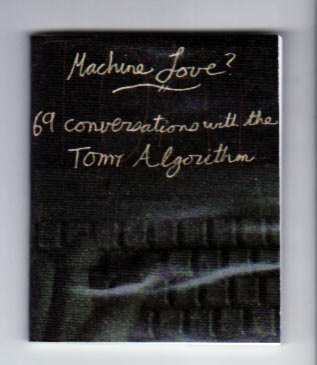

Documentation ranged from video, to generated text files
played as videos in Quicktime , and even the publication of a small book
of receipts
chronicling
the results of one of the oracle machines.
While I continued working
in sound composition, I was still not playing instruments; I was,
however, playing
video games.These games were controlled using a two-handed keypad
and about
a dozen different buttons, one (at least) for each finger. To succeed
at the game, one must be able to punch complex strings of code
out using these
buttons, working in a kind of strange, unconscious rhythm.
I would often look down at my hands and find myself surprised at the complexity and speed of their automatic motions, thinking that if they could be applied to a keyboard, rather than a keypad, something truly compelling, and different, might emerge.Using an old Hammond organ in the back of Fort Thunder, I stopped playing Street Fighter and became mudboy.
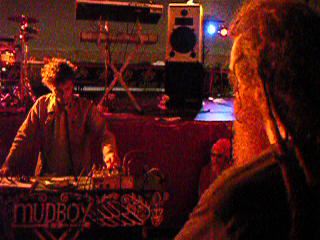
In these early days of working as a musician, the early minimalist
composers I had studied as an undergraduate remained in the
back of my mind, while
life at Fort Thunder put me shoulder to shoulder with contemporary
experimental musicians who were releasing their music using
CDr and cassettes. Originality
and creativity were my personal objectives, and though I
continued to be impacted by Raymond Scott, Terry Riley and Nobukazu
Takemura,
it was the
culture of this revolutionary space that provided me with
the intellectual permission to discover a language of my own design.
The second series of mudboy recordings, inspired by the awkward collapse
of simple mathematical arpeggiating circuits built into the organ itself-
against the irregular playing of a human new to the keyboard became, mudboy
Volume II- Or Further Adventures in Time, Space, Math and Other Tonal
Inconsistencies, and was
released in 2001.
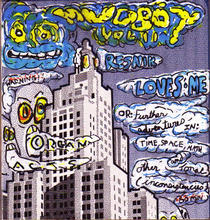
Track
5:"Flee- Fleet!" (2'10)
In the beginning, mudboy was simply a recording project,
using the Hammond organ and a four-track recorder. I
would return again
to the
looped sounds
that had marked the automatic composition of my earlier
works on MAX, but for now I was playing live, improvising
within
the framework of
public performance and with a variety of electronics
and looping effects. My intellectual interests drew me to the parallels living
systems, including ant farms, traffic patterns and animal
migration routes.
As a composer, I
developed ideas and images derived from my personal research
into forms of music that were circular systems of sounds,
without too much emphasis
on
the notion of sequence or temporal development. This
densely atmospheric mode of composition still marks my
present work,
which focuses on the
narration of movement through described landscapes and
the negotiation of sonic events.
Much of this work was compiled in 2004 for the Last Visible
Dog label.
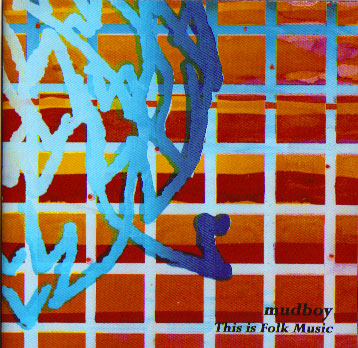 Track
7: LOST (8'10)
Track
7: LOST (8'10)
Later I would begin tinkering with the Hammond organ,
increasing my palate of sounds; eventually I would take
a circular saw
to it, cut
it in half,
and bring it on tour.
I also brought my laptop, with its MAX program,
on tour, but (unlike the Hammond), it did
not survive. Realizing
that the
computer was
too unreliable
and fragile a machine to be used as an
adjunct in
live performance, I began to consider it
only as a compositional
tool in the
creation of
multi-track
recordings; as a result, I began to think
of my musical pieces as a form of sculptural or filmic
activity, in
which large amounts of
source
material
are sorted and gradually reduced into
smaller, more concise moments. My experimental sound
work with
Free Matter
for the Blind began
to leak into
the mudboy compositions,
Solitron Wave (5'14)
In 2005 I produced a series called "The
Haunted Cobblestone Sunset Concert Series.”
Although
I had begun to use field recordings in my life performances
and on the
mudboy albums, I now
wanted to
create a situation
in which live,
unrecorded, and unpredictable sounds
could be layered
onto the arc of a live performance.
The Haunted Cobblestone series was,
accordingly, a ten- part performance series in which
invited musicians improvised
live out of an open
window. The musicians could not be
seen by the audience, which was seated on
the street below where it would be
confronted with passing cars, playing children,
and neighboring songbirds. Each performance
would begin
in
the early evening one hour before
sunset, so that its final moments
would coincide
with those
of the setting sun.
Musical elements
included acoustic accordion activity (Exerpt:
Alec Redfearn),
triggered
samples and looped
guitar, (Excerpt:
Area C),
to an 9-11
anniversary performance
which featured the occasional burst
of AK47 gunfire at actual volume ricocheting
down
the street,
accompanied by the live
sound of a
sledgehammer dismantling
a handful of electronics and furniture.
(Excerpt:
Jason McGill),
This was followed by the release
of Psicklops, an investigation
of what
I characterized as "dark
cinema," and
the production of a point-of-listening
perspective in sound-only
narratives. Psicklops hoped
to begin to develop
counter-possibilities to
Marcel Duchamp’s
provocative statement, “It
is possible to show someone
looking, but
you cannot
listen to
someone. ”
In traditional cinema,
"the gaze" or watching
someone look, is the fundamental
semiotic
basis for the
creation of the
illusion of perspective
through space
and time; Psicklops
asked if the same ends could
be achieved
in
a narrator-less
audio
narrative.
Conceived
as a contemporary adaptation
of
Kafka’sThe
Trial, Psicklops
used a
multi-textured
collage
of found
sounds,
guerilla
field
recordings,
sampled
creative
common
works,
studio
actors,
and
experimental
electronics
to
create
a one hour
long operatic
experience
in which
the audience
is treated
not just
as
an outside
observer,
but
complicit
in,
and anticipated
by, the
work
itself.
With support
from
the Rhode
Island
State Council
on
The Arts,
I
experimented
with distributing
the piece
as
a film,
and screenings
were arranged
so
that an
audience
could appreciate
the work
as a self-contained
recording
in a
darkened
room. These
screenings
were held
over
one week
in over
50
locations
around
the world
with a
series
of
international
transmissions
involving
two
dozen
radio stations.
Excerpt
1
Excerpt
2
Excerpt
3
Later that
year,
I received
a
grant
by the Rhode
Island
Arts
Council to write
a series
of pieces
for the
Mighty
Wurlitzer
Theater
Organ,
one of
which
was housed
at the
Performing
Arts
Center in
Providence.
Historically,
the Center's organ
has only
been used
to play either
pop concerts
or traditional
music to an older
audience. The
grant allowed
for a free concert
of experimental
compositions and
was geared
toward a
younger group
of individuals who might
otherwise only
listen to music
in clubs and parties.
For me,
the appeal of the
instrument was
that unlike
contemporary keyboards,
which assign
a complex
sound to one
set of
keys, the pipe
organ had
five keyboards,
each of which could
be assigned to their
own set of
sounds. I
was able to play
patterns on
one set of
keys while an
assistant manually
pulled stops
to allow
for a constantly evolving
sound. In
addition, because
it was a theater
organ— intended
for accompanying performances and films—, it allowed for the incorporation
of a great number of percussive and non-musical elements. In many ways, it
was the ultimate analog acoustic noise instrument. The recordings were released
by the magazine The Sound Projector a few years later.
Desert
Things (6'47)
Solo
Work
Better
Left
to
Feet (5'59)
Wonder
Show of the Universe(14'16)
The experience of working on the Wurlitzer inspired the creation of the “mudboy mini," an electroacoustic keyboard built around an integrated harmonium and yamaha synth.
In
2007, I
would enter
a transmission
arts residency
at the
radio station
Free103.9 to
study the
history and
possibilities of
traditional radio
theater. My
goal was
to develop
a concise
semiotic theory
around the
idea of
a sound-based
narrative perspective,
one that
would be
as robust
as the
one I
studied as
a film
student at
Brown. The
result of
my research
at Free103.9
was a
decision to
move away
from film's
emphasis on
the gaze
as the
ground of
perspective—what
Duchamp called “looking at looking”—and towards an understanding
of listening, in particular guided listening, as a fundamentally hypnotic
and therefore expansively proprioceptive event.
This
study encouraged
me to
explore
the potential
for using
the voice
as both
a conduit
for semantic
information
and as
a means
of orienting
the audience
towards
a particular
and peculiar
experience
of listening
estranged
from
verbal
or linguistic
communication.
Relying
on the
manipulation
of the
extra-semantic
signifiers
of speech—including
affect,
intonation,
and
various
modes
of prosodic
experimentation—,
my
work
from
this
period
attempts
to
create
musical
phrases
that
submit
the conventions
of speech
to a
provocative
deformation
.
Taking
my cue
from scientific
studies
on
cognition
and
audio
perception,
which
remain
fundamental
guiding
influences,
I
began
to
experiment
with
the
spectrum
of
the
spoken
word
from signifier
to
musical
phrase.
This
took
the
form
of
several
pieces, the
following
is
from
my
LP
entitled “Let
It
Be a
Nightingale
Then.”
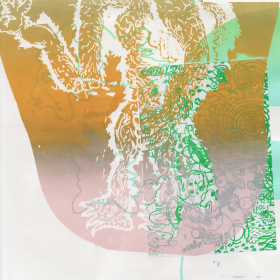
The first track, Instructional
Video for This Side (6'46)counterposes
two sets of indecipherable language, one human, and the other avian.
Meanwhile,
in "Mudmantra for Conquering Death," a video installation with
Dave Fischer using generative video software, three layers of language are
used, some, none, or all of which—depending on the language background
or skills of the listener—may
be
intelligible.
Mudmantra
video *80 megs- load, (4:00)
Mudmantra
audio only
These
theories
paralleled
my
refinement
of
the
mudboy
live
performances,
which
were
increasingly
anchored
around
my
sense
that
music, language and focused group attention are a
tool
for
the
creation
of
what
I
refer
to
as
a “human state change.” The
operative
metaphor
for
this
new
kind
of
work
was
derived
from
occult
histories
of
magic
and
spellcasting,
and
of
the
shamanic
tradition
of
the
composer
as mediator
between
the
conscious
and
unconscious
mind of
the
audience.
My performances, some of which used firecrackers as sound elements, along with any number of lighting effects- created a fully immersive experience for the audience described by online journalist Nate Dorras follows:
One by one the lamps and droplights are doused, and the stars
come out.
Through the vapor of a weakly sputtering fog machine they wink, deep blue
pinpricks atop the non-invisible speaker tower and strewn across the floor
before the seated audience.
There is an all-encompassing chorus of insects. Perhaps frogs. Night sounds.
Vague illumination is provided by the diffuse glow of the windows and a trio
of candles arrayed around a custom-built wood-housed organ, but the scattered
stars most draw the eye. As well as, by their barest gleam, the dim form
that picks its way between, swinging a bunch of smoldering incense like a
somnambulant priest bearing a censer. Organ notes cycle blankly against the
swirl of natural sound. "Each life, a light." The air is sweet
and smoke-embellished...
His eyes blink bitter red. With a lunge, we are suddenly blinded. There is
a roaring in our ears, vision swims to make sense. As he spins, we see: he
grasps one of the droplights, turning its harsh light directly down on us as
he calls out again. And then he is swinging that light by its cord. A comet
arcing just over our heads. The audience is transfixed, or I am; I am no longer
aware of them around me. And then the roar breachs and falls away, the light
dying, all easing out more careful organ sequences and wearied, stumbling drums.
Text by Nate Dorr: February 06, 2009
http://www.imposemagazine.com/photos/mudboy-at-silent-barn .
One
of
these
performances,
a
live
session
at
VPRO
radio
in
Amsterdam,
was
recently relased
by
the
prestigious
Staalplaat
label in a folded wooden box.
. Excerpt,
3 min
Excerpt,
3 min
In
2008,
the
album Hungry
Ghosts! – These
Songs
are
Doors
was
released
by
NotNotFun
as
an
LP,
before
being
re-released
by
Digitalis
Industries
later
that
same
year.
Hungry
Ghosts! was
constructed
in
such
a
way
as
to
invoke
as
the
cognitive
state
of
a
waking
or
lucid
dream:
each
song
was
a
new
vision,
buried
inside
the
other.
By
now,
all
the
recordings
on
the
album
were
taken
from
computer
compositions,
the
product
of
slicing
and
re-arranging
many
sessions
and field
recordings
to
create
a
complex
whole.
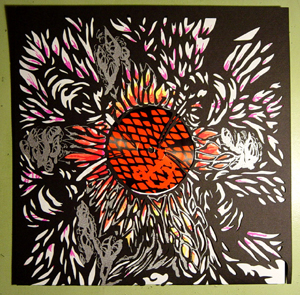
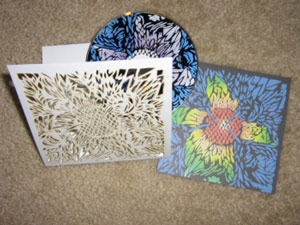
Shockwave track 7 (4:22)
RECENT WORK
My recent work is a response to the conviction that, as Peter Brown puts it in
The Hypnotic Brain, “the neurobiology of hypnosis overlaps with the neurobiology
of music.” The dissociation critical to hypnotic phenomena hinges upon
a disengagement of a critical aspect of consciousness. That disengagement is
generally accomplished through a kind of distraction, and through the entrapment
of an irresolvable field of change and motion that nonetheless hints at a kind
of resolution, however compromised.
While we can easily imagine a slightly swinging watch, or the shadow of a flickering
candle flame to accomplish this distraction, there are clear similarities between
the techniques of trance induction and many kinds of even traditional and classical
music; and that furthermore there is a close affinity between this irresolvable
field of change and the disassociative effects of certain natural and chaotic
shapes in nature.
The project of composition that arises from these theoretical interests is not
so much a literal re-interpretation of organic processes as inorganic sound—resulting,
say, in a Max/MSP-generated invocation of a coastline, or flocking gulls—but
rather the negotiation of a synaesthetic relationship between the branching pattern
of certain trees, and of those of serial music. The compositional results of
these investigations are exemplified in the piece “Swamp Things,” which
exists currently in two versions:
the
first is played live on the Wurlitzer (14'16) in
the previously mentioned concert,
and the
second is an electronic recording
using
circuit bent keyboards and effected guitar.(9:29)
As in most of my work the specific instrumentation is second to the conceptual
framework.
The same basic organizing principles govern the The Black Creek track from an
upcoming LP that is the first of a series entitled mudboy’s Impossible
Duets. The Black Creek is conceived as duet between myself and the creatures
of the bog near my family’s farm in upstate NY.
(3
min excerpt)
Of course, this notion of the “shape of nature," which mediates these newest compositions, is-in mathematical terms- a conversation about fractal organization. As the granular manipulation of time and duration within a sample or musical phrase became easier on account of advances in computer software, it has become possible to organize a piece of electronic music without regard to tempo and only in regard to "shape". If music is, theoretically, effective because of its internal structural relationships, and if those relationships were organized in such a way as to remain visible through different extreme variations in tempo, we may begin to create a truly fractal piece of music – one which could be played at any number of speeds and still manifest the same motifs and relationships.
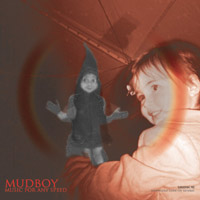
Early explorations of these possibilities inform my most recent projects. Released
on 7" vinyl, Music for Any Speed, uses a record player as
a performer in collaboration with the owner of the record. The album was
a looping
bi-faced composition;
one side, Thaw,(4'32
at 33rpm)
expressed an exuberance and almost impossible rapidity
which devolves into
Freeze, (6;20
at 33rpm)
the reverse side of the album that turns the same notation
in a frozen wasteland, built around a granular representation of the first
track and then back again. Ideally, the two pieces could be played at any
speed, one right after the other, seamlessly, without beginning or end.
My interest in fractal living systems as an organizing creative principle
has had its analog in the installation and art work I continued to do in
the gallery and public space. . There seems to me a clear relationship
between looping musical improvisation within given limits, and the composition
of kinetic objects in time.
The complex system
based work of Peter Fischli and David Weiss, for example,
and the circular work of Arthur Ganson
can be seen along this same conceptual spectrum of composition.
The ideas remain the same, as does the longing to produce wonder in a modern
age—only the media has changed.
Imagined as a composotion without a performer, my most recent gallery pieces
use windows and immersive installations to transform kinetic lights and projections
into visual representations of the same sort of state-based organization inherent
in the music compositions which surround them. My desire is still to provoke
an experiential change in the viewer, but this time that change is created
through the optical illusions of 8bit controller programmed kinetic lighting
effects. In this case the composition remains buried inside the coding itself.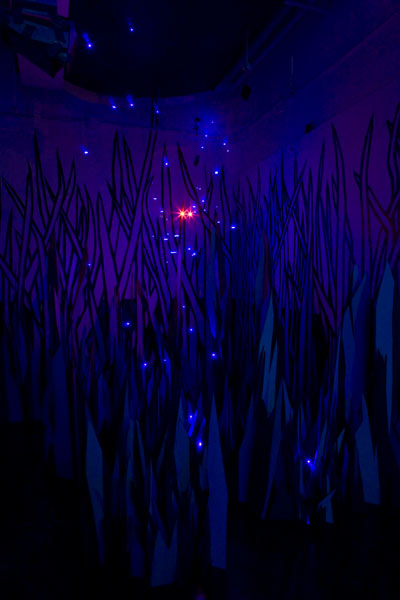
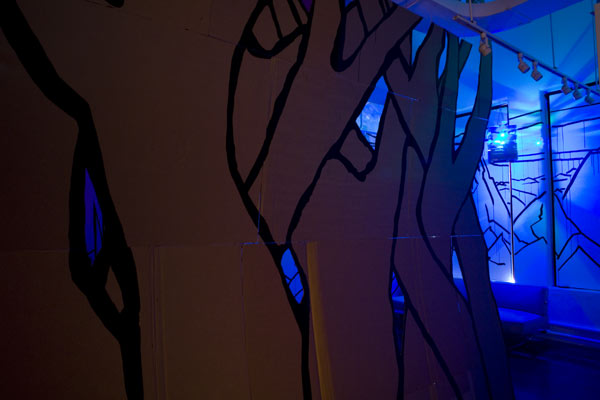
GRADUATE STUDY
If the task of a composer, as I see it, is to conceive, program, and perform
a guided experience I must learn what it means to compose not so much for people
for as perceptual systems. As I ask my reader (and myself), in the liner notes
for Impossible Duets,
“What does music do, and how does it work?”
This
is not meant as a Cagean inquiry into the sonic specificity of music itself,
but rather an invitation to consider how music mediates the relation between
the human and animal, between organic and inorganic, between worlds both
built and natural. Does the ineffable enchantment of organized sounds
bear a familial
resemblance to the chaotic forms of fire? Or else to the mountain ridges
and schools of translucent fish by which we are so mysteriously and
inexorably
compelled? What could evolutionary biology and cognitive science teach us
about the Classical symphony
composition that extent theoretical investigations have not?
Graduate study at Columbia University would allow me to refine the conceptual
tools necessary to cultivate my potential as an composer and knowledge creator,
specifically by allowing me to synthesize the diverse interests I have pursued
over the
years
within
the context of a rigorous intellectual community. The opportunity to learn
from professors like Fred Lerdahl, Bradford Garton, and Tristan Murail, and
to collaborate with those scientists and musicians engaged in the investigation
of the mind and its relationship to musical language, would have an immense
and transformative effect on my compositional and artistic practice. As an
artist who has drawn inspiration from many forms of media, I am excited by
the possibility of committing myself to the study and composition of chamber
and orchestral music, and to take part in the pioneering research into of
traditional forms for which Columbia’s Department of Music is celebrated.
I hope to invigorate my own work through a productive confrontation with
those musical
traditions which my own practice has hitherto deemphasized, and to use my
experimental methods to make provocative contributions to the scene of contemporary
music.
I have no doubt that our collaboration would be hugely significant- and
exciting- for us both.


